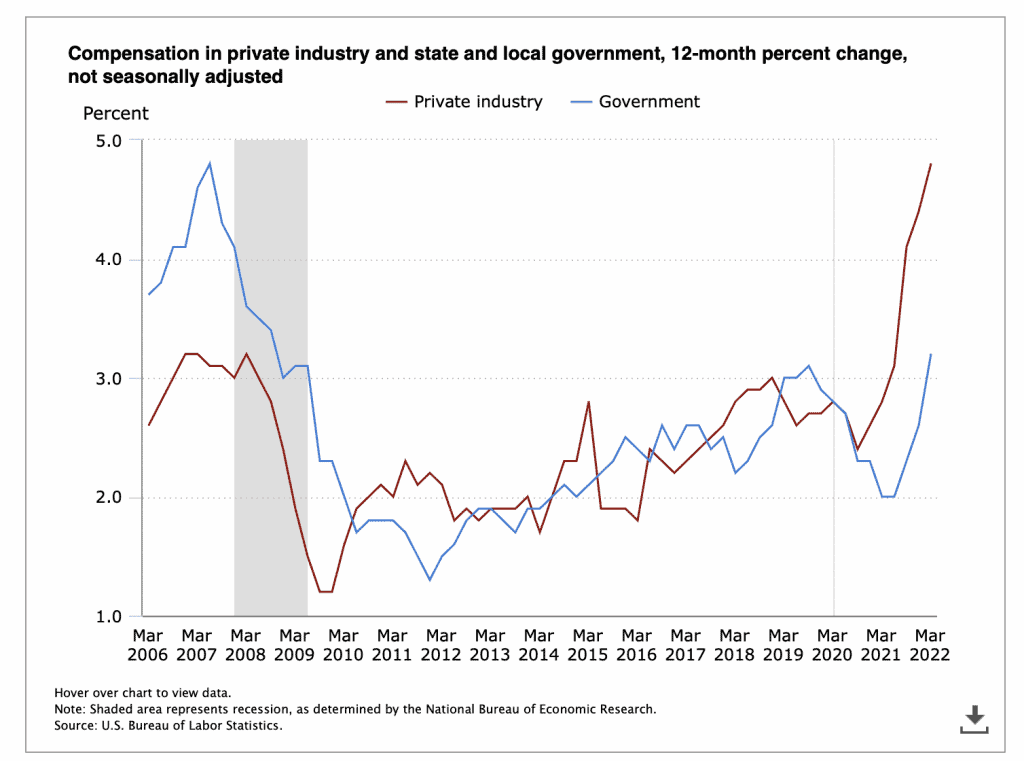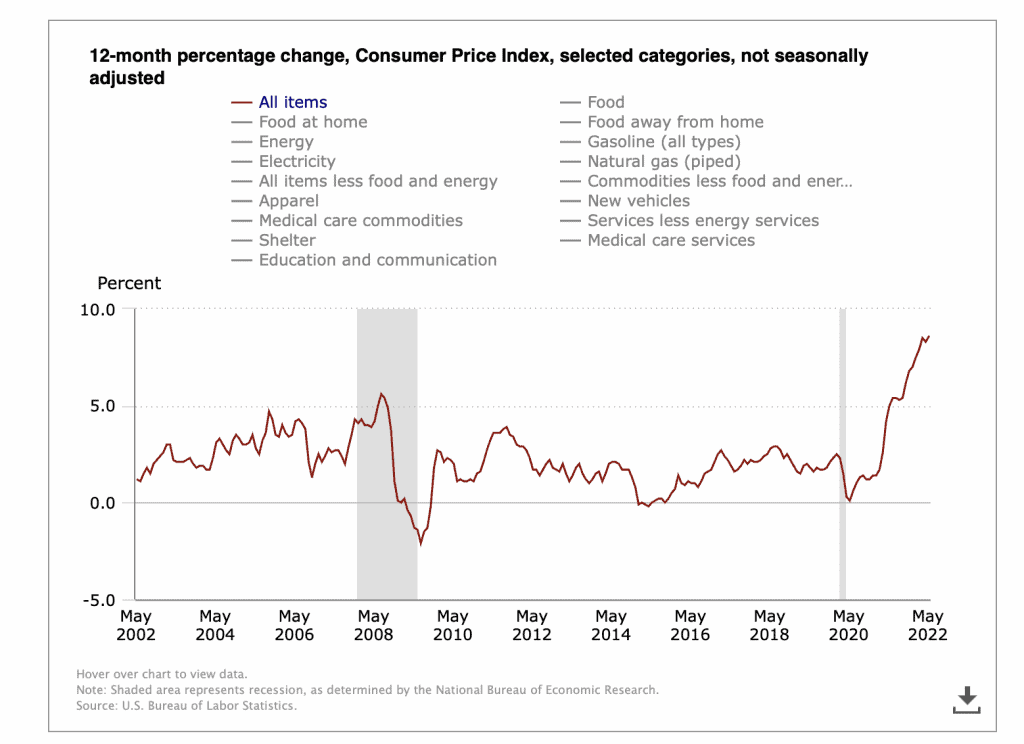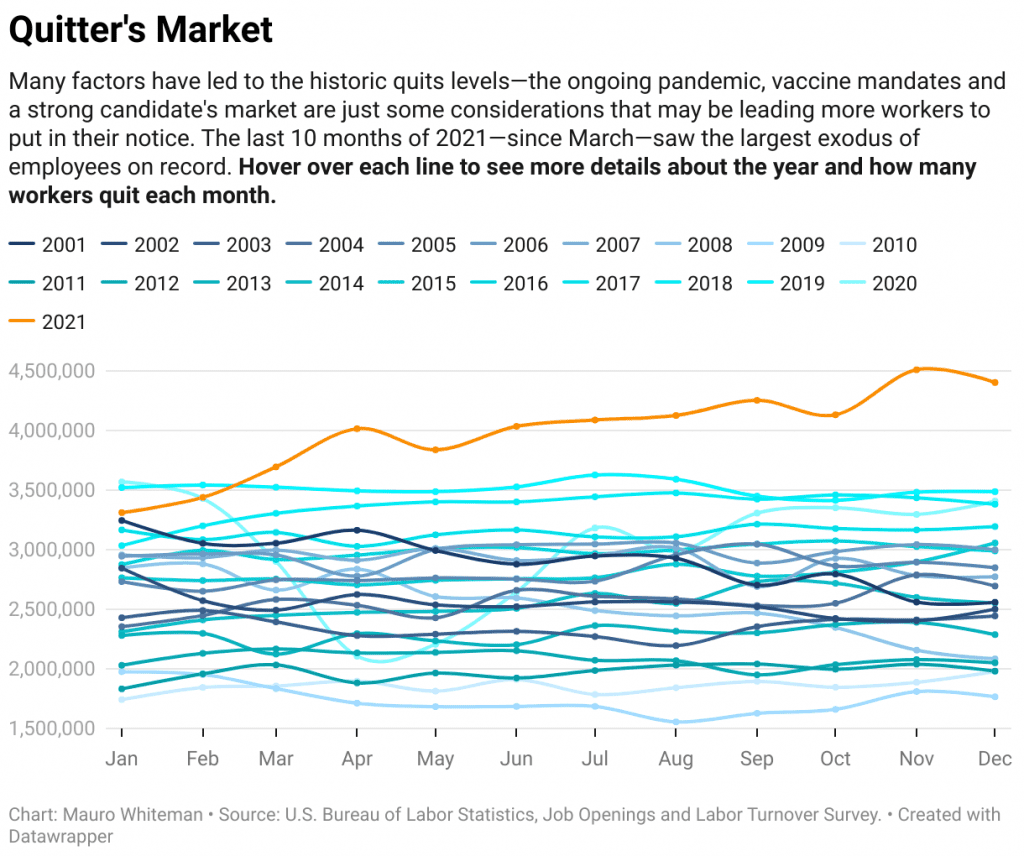
Level Up Your Business Today
Join the thousands of people like you already growing their businesses and knowledge with our team of experts. We deliver timely updates, interesting insights, and exclusive promos to your inbox.
Join For Free💳 Save money on credit card processing with one of our top 5 picks for 2025
General economic inflation has led inevitably to widespread salary inflation. Small businesses owners may need to make significant changes to payroll to stay competitive.

If you run a small business, the question “how does inflation affect salary increases?” may be top of mind for you right now. But does economic inflation always lead to salary inflation? And how large should an employee’s raise be, considering inflation?
Record-high inflation hits employees and businesses alike, and ideally, employee salaries should increase as inflation does. However, as businesses battle financial setbacks and rising costs, employee raises are becoming more challenging every day.
This guide will help you navigate inflation’s toll on employee salaries, including an in-depth look at how inflation affects salaries, whether businesses should increase salaries due to inflation, and how to calculate employee raises.
Table of Contents
Inflation and salary increases generally follow similar trends, but salary increases and inflation don’t follow a one-to-one ratio. For example, if inflation increases in the US, salaries have historically increased as well, but not always by the same percentage of the inflation increase.
While both inflation and salaries are increasing, inflation is increasing at a much higher rate than salaries. At the current rate of inflation, some salary increases are being wildly outpaced and effectively canceled out. However, inflation’s effect on salary is a nuanced issue with many contributing factors to consider.
Keep reading for a more in-depth explanation of inflation and employee compensation in the US.
Historically, inflation and wage increases tend to follow the same trend, but don’t keep pace with one another.
The Consumer Price Index (CPI) measures the cost of goods in the US and serves as a metric for inflation. Per the CPI’s latest publication, the US is currently experiencing inflation rates of 6.5%. While the inflation rate has gone down slightly from 8.6% in June 2022 to 6.5% in January 2023, the concern over inflation and how businesses can weather it has not gone away.
According to the US Chamber of Commerce, small business owners are increasingly concerned about inflation.
Inflation is really hitting small business hard, and that reality is negatively impacting their confidence, their ability to hire, invest in their businesses, and grow.” – US Chamber of Commerce
Alongside inflation, compensation costs are rising. A year-over-year comparison ending in March 2022 showed that compensation costs increased by 4.5%. Wages and salaries increased by 4.7% in the same period. In short, businesses are spending more on employee pay, payroll taxes, benefits, and any additional employee earnings.
However, when you factor in inflation, wages and salaries in the private sector decreased by 3.3% in the same 12-month period ending in March 2022.

[Source: US Bureau of Labor Statistics]
In addition to the usual factors that influence inflation, there are a number of unprecedented and not easily remedied factors that have contributed to the current rate of inflation.
Lingering supply line issues related to the pandemic, Russia’s invasion of Ukraine, and high fuel costs have all created the perfect storm of factors to drive inflation up. None of these issues have simple, tidy fixes, so high inflation is likely here to stay for the time being.
The Fed is working to reduce inflation, but even so, an economic recession is becoming increasingly likely. Moreover, interest rate hikes are unlikely to impact the economy immediately; it generally takes a year for rate hikes to make a significant difference.
While President Biden’s gas tax holiday plan may alleviate some pain at the pumps, there’s not much that will take away from the fact that energy prices have increased by 34.6% in a year-over-year comparison for the period ending in May 2022.

[Source: US Bureau of Labor Statistics]
Employees in the service industries saw the largest salary increase at 7.8% — though the industry also saw the largest rate of quitting, as employees left in droves during The Great Resignation — beginning in the spring of 2021, employees were leaving jobs in mass for a variety of reasons. Conversely, those within the construction, maintenance, and natural resources industries saw the lowest rate of compensation growth, at just 4% in the year.
Whether businesses should increase salaries because of inflation depends on your business’s bottom line. Whichever way you slice it, employee raises cost money. When you factor in the current rate of inflation, giving employees, at minimum, an 8.6% wage increase just isn’t feasible for many businesses.
However, even if your business does not have the funds to raise salaries to match inflation, it’s essential to consider inflation alongside traditional raise factors when increasing employee salaries. A 6.5% inflation rate is simply too impactful to ignore when deciding on a fair wage for your employees.
Moreover, as the Great Resignation has shown, employees aren’t afraid to search for jobs that offer better pay and benefits.
Pros
Cons

[Source: shrm.org]
Whether your business is considering raising employee salaries or you’re an employee looking to propose a raise, calculating a salary increase can be a complex process.
To start, there are two different types of salary increases to consider:
Regardless of which type of raise system your business uses, you’ll need to know how to calculate an employee’s salary increase. With a salary increase calculation, you’ll be able to give your employee a clear number when providing the raise and have hard numbers to work with when handling the accounting forecasts for your business.
Below, we’ll break down the steps to calculate pay increases for your business.
Regardless of whether you choose a fixed raise or percentage raise for your employees, you’ll need to figure out how much to increase salary. When deciding how much to raise wages, you should consider:
While salary increase considerations will vary from business to business, it’s important to stay as consistent as possible within your own business. Not only will this help provide transparency for your employees, but it will also help to keep things fair for employees in the same position.
Once you have a new wage rate, you can apply that rate to your employee’s current wage to get a better understanding of the raise’s impact on your business’s bottom line.
To calculate an employee’s new wage after a raise, you’ll need to either:
All this means is that you’ll need to plug numbers into an equation. For fixed raises, the equation is as simple as:
Current Wage + Fixed Raise Amount = Employee’s New Salary After Raise
If you’ll be raising your employee’s wage by a set percentage, the equation looks like this:
(Current Wage x Raise Percentage) + Current Wage= Employee’s New Salary After Raise
When using this equation, express the percentage as a decimal (eg. 40% changes to .4).
To change a percentage to a decimal, simply take the decimal point and shift it left two spaces. If your percentage doesn’t have a decimal point, add .0 to the end of it before converting the percentage to a decimal. For example, 40% becomes 40.0 which converts to .4.
Let’s see this in action. Let’s say your business has an employee that earns $50,000 annually. You want to provide that employee with a 5% wage increase. Plugging those numbers into the equation from above:
($50,000 x .05) + $50,000 = $52,500
With a 5% raise, your employee would go from earning $50,000 per year to $52,500 per year.
Although you’ve got your employee’s new wage sorted, you’ll need to consider the real cost of employee raises to determine whether it is financially feasible to provide your employee with said raise.
With the current rate of inflation, employee earnings are down 3.3% in the last year, despite employee compensation costs rising. While employers are responding to the rising costs by paying employees more and providing more benefits, anything short of a pay raise that is on pace with inflation is effectively a decrease in pay.
However, as employers and employees are impacted by inflation, it can be challenging or impossible for businesses to provide employees with an 8.6% wage increase across the board.
So, if you’re concerned about providing employees with a fair living wage, do what you can. First and foremost, any wage increase should be financially feasible in the long term. It won’t do much good, to your employees or you, if your business tanks in a year. Consider saving on payroll costs by switching to one of the top cheapest payroll software options.
If you can’t offer a wage increase, consider improving employees’ benefits package. Allowing employees to work from home, improving employee health insurance packages, providing a stipend for childcare, and adding flexible PTO options are all excellent ways to cater to employees’ well-being.
Salaries and benefits are all a part of the payroll process, if you’re interested in learning more about how to improve payroll for your business, check out our guide to payroll best practices.
Get in touch with a real human being on the Merchant Maverick team! Send us your questions, comments, reviews, or other feedback. We read every message and will respond if you'd like us to.
Reach OutGet in touch with a real human being on the Merchant Maverick team! Send us your questions, comments, reviews, or other feedback. We read every message and will respond if you'd like us to.
Reach Out
Let us know how well the content on this page solved your problem today. All feedback, positive or negative, helps us to improve the way we help small businesses.
Give Feedback
Want to help shape the future of the Merchant Maverick website? Join our testing and survey community!
By providing feedback on how we can improve, you can earn gift cards and get early access to new features.
 Our reviewers like ADP Payroll for its advanced employee management, strong payroll features, and great customer support. For a limited time, get three months free.
View Offer
Our reviewers like ADP Payroll for its advanced employee management, strong payroll features, and great customer support. For a limited time, get three months free.
View Offer
Help us to improve by providing some feedback on your experience today.
The vendors that appear on this list were chosen by subject matter experts on the basis of product quality, wide usage and availability, and positive reputation.
Merchant Maverick’s ratings are editorial in nature, and are not aggregated from user reviews. Each staff reviewer at Merchant Maverick is a subject matter expert with experience researching, testing, and evaluating small business software and services. The rating of this company or service is based on the author’s expert opinion and analysis of the product, and assessed and seconded by another subject matter expert on staff before publication. Merchant Maverick’s ratings are not influenced by affiliate partnerships.
Our unbiased reviews and content are supported in part by affiliate partnerships, and we adhere to strict guidelines to preserve editorial integrity. The editorial content on this page is not provided by any of the companies mentioned and has not been reviewed, approved or otherwise endorsed by any of these entities. Opinions expressed here are author’s alone.
 Our reviewers like ADP Payroll for its advanced employee management, strong payroll features, and great customer support. For a limited time, get three months free.
View Offer
Our reviewers like ADP Payroll for its advanced employee management, strong payroll features, and great customer support. For a limited time, get three months free.
View Offer